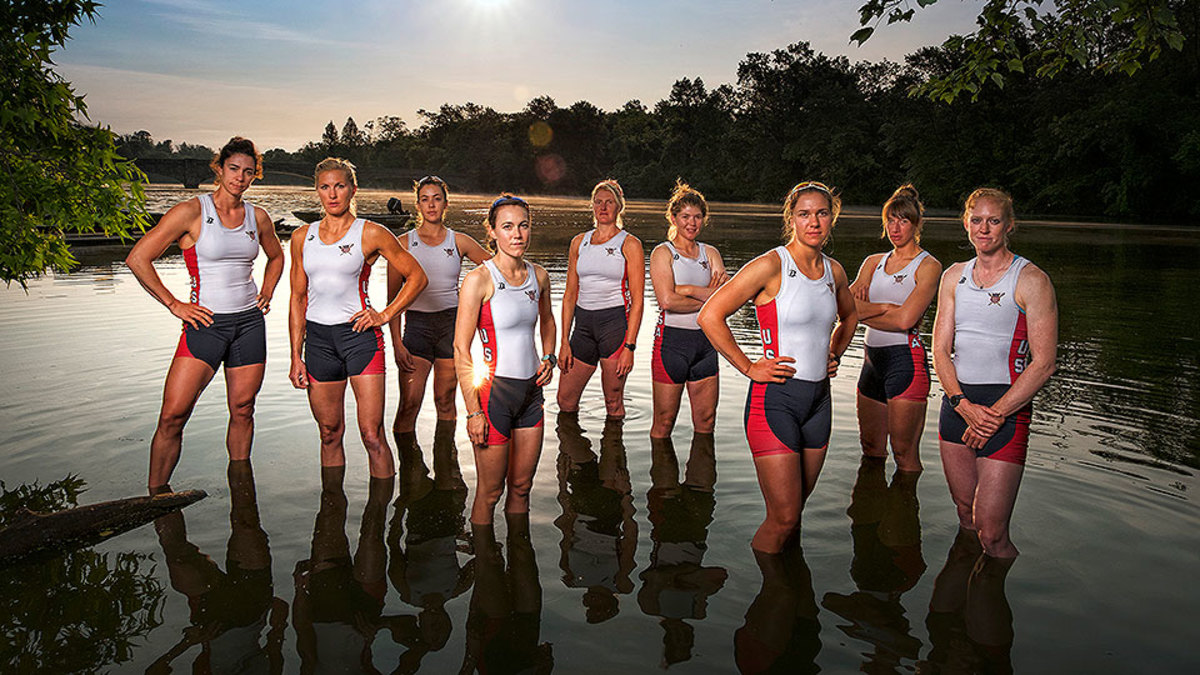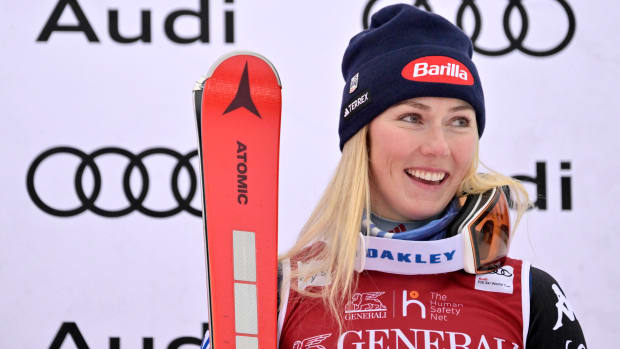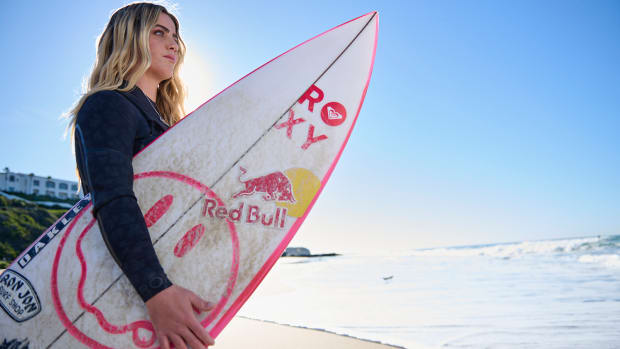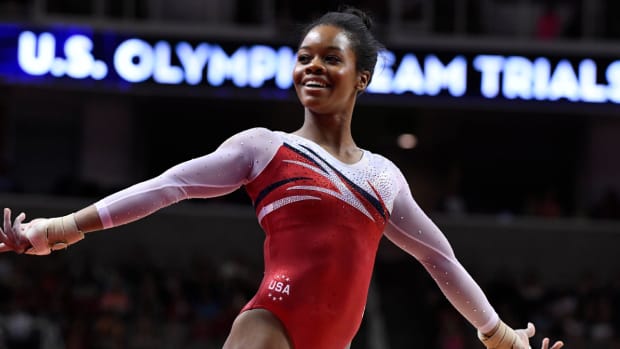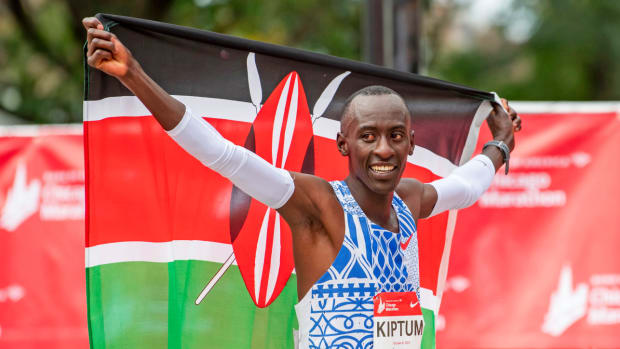The Unbeatables: U.S. women’s eight is the most dominant team in Rio
For six weeks, from the Olympics opening ceremonies to the Paralympics closing, men and women represent their country with one common goal in mind: Gold. Subscribe now for SPORTS ILLUSTRATED’s in-depth coverage.
On a still and muggy morning, the first full day of summer, nine young women gather in the shade beside the C. Bernard Shea Rowing Center at Princeton, the home base of USRowing. In shorts and tank tops, barefoot or in flip-flops, hair pulled up and sweaty, they mill about, chatting, laughing, checking phones and taking long pulls from water bottles. The first workout of the day is done. Under their normal schedule—what they’ve been accustomed to for the past four years—they would be off to rest now, eat, maybe grab a nap before the afternoon’s training session. But today is a little different. Today they have a photo shoot scheduled, as well as video interviews to record and a reporter to talk to. Routine was scuttled for these athletes late on the previous afternoon when they were officially named to the U.S. Olympic women’s eight for the Rio Games. This morning they woke up as the latest embodiment of the longest-running dynasty in Olympic sports.
Beginning with a victory in world-record time at the 2006 world championships, the U.S. women’s eight has won 10 straight world or Olympic titles. (Closest comparison, perhaps: the Soviet Union’s 10 consecutive world and Olympic gold medals in men’s ice hockey, from 1963 through ’72.) Now the nine women assembled here this morning know that in just a few weeks they will head to Rio as a heavy favorite to continue the historic U.S. streak and bring home a third straight Olympic gold medal.
Sports Illustrated At The Games
Subscribe to SI's Olympic podcast coverage
How heavy a favorite? Well, as Martin Cross, a gold-medal-winning rower for Great Britain who who is now World Rowing’s lead TV commentator, puts it, “In terms of their competitors, I think everyone is in awe and in fear of them, probably in equal measure.”
But to a woman, the newly minted U.S. Olympians will tell you that they are not thinking about the streak or about any of the competitors they will face in Rio but are focusing only on getting the most out of themselves and their boat. “We try not to dwell on the past success,” says Meghan Musnicki, who, as a veteran of the 2012 team, is one of only two former Olympians on the ’16 crew. “We know where the bar has been set. Now we’re trying to push past it.”
Says two-time Olympic gold medalist Elle Logan, “We’re just trying to take in the moment. We can only control what we do.”
Rowing is unlike every other team sport. Having a star or two in an otherwise undistinguished squad won’t elevate the boat. A single rower can’t get hot and carry the rest of the crew. There are obviously no substitutions or situational specialists. The eight oarswomen and coxswain in a boat must function as a unit from the first meter to the 2,000th.
“When it’s right, all nine of us can feel it,” says Katelin Snyder, who as the coxswain will be responsible for coordinating and driving the U.S. crew during races in Rio. Though these will be her first Olympics, the 28-year-old Snyder, who coxed the men’s eight at Washington, knows just how right can feel, having been the coxswain in four of the U.S.’s world-championship-winning boats. She also knows just how tenuous that state can be. “Even if one person is off, the boat just doesn’t feel right in the water,” she says. “But the more you are together, the more you can get the boat to work. You hit that rhythm that is rowing’s holy grail.”
• From TIME: Meet the U.S. coxswain turning tragedy into triumph in Rio
Tom Terhaar calls it balance. “And,” says the man who has coached the U.S. women’s eight to every one of its 10 straight golds, “it’s not there most of the time. But it’s what you are working for all the time.”
Ask anyone in the rowing world about Terhaar, and it’s likely you’ll hear some variation of the term soft-spoken. You’ll also hear modest a lot. But the 46-year-old former rower at Rutgers and coach at Columbia, who took over as women’s coach for USRowing in 2001, runs his program with unmistakable seriousness and intensity, and he brought immediate success. The year after he arrived, the U.S. women’s eight won its first world title in seven years. Two years after that, in Athens, the boat took second, claiming its first Olympic medal in 20 years.
Mary Whipple, the coxswain on that boat, who would go on to cox the winning eight in 2008 and ’12, calls that silver in Athens “the opening of the floodgates,” and she credits Terhaar with providing the key. “He really knew how to motivate us,” she says. “He gave us the belief that we could do it.“
He also gave his athletes the fitness and the skills, built through countless hours on the water, in the rowing tanks and on the ergometer. At the heart of Terhaar’s approach is the notion of building “boat feel,“ which he describes as ”using the water to move the boat.“ To that end, his rowers spend a lot of time throughout the year training in singles and in pairs—where technique and touch can be more easily observed and honed—even as they continue to be mixed and matched with one another in different eights.
“Most of our international competition will start off in singles, at a young age, so they’ve got a lot of boat feel,“ says Terhaar. “But most of our kids come in [to the U.S. program] from eights, with a lot of heart and a lot of power and aggressiveness and an excitement to race. So we almost slow things down, by dropping them into the smaller boats, letting them learn. It’s a different approach, probably, than everyone else’s, but it’s been great for us.“
After the Lightning: Track and field’s newest stars ready for the spotlight
Terhaar credits much of his program’s success to the increasing depth of talent coming out of universities. Women’s rowing in the U.S. took off after the passage of Title IX in 1972, as schools sought to equalize their sports offerings, introducing more women’s programs to offset the men’s numbers, particularly in football. Now dozens of colleges across the country, from the early powerhouses of the Ivy League to Wisconsin, Washington and Cal, have robust women’s programs, producing a whole new generation of rowers, many of whom didn’t even start until they were exposed to the sport in college. Though they may not emerge with the technique and years of experience that their international counterparts possess at the same age, Terhaar says, the American rowers come out with something even more valuable. “They know how to race [in an eight], and they’re strong,” he says. “They’re used to being on a big team, and that’s huge. They’re used to not being overly handled, to realizing that when they need to know something, they’ll get help.”
They also get a support system that allows them to focus on training. Athletes with the national program receive a stipend from USRowing that varies according to the athlete’s ranking and competitive results, as well as health insurance. In addition, in Princeton, a network of host families provides year-round room and board for a majority of the rowers on the national team. Some of the families have been in the program for three or four Olympic cycles.
Their living situation thus set in what some have called the “Princeton bubble,” Terhaar’s athletes can face the daunting daily challenge of keeping up with their teammates. “They learn it here,” says the coach. “If you think you’re good but you don’t do the work, you won’t keep up. One bad day, and you can go from No. 7 to 17.”
Emily Regan, 28, remembers her introduction to the program. She arrived at Princeton in January 2011, after graduating from Michigan State the previous year. Thrown to the wolves is the phrase she uses, with only a small laugh. “I was so intimidated by every woman here,” she says. “They were all so fast.” Regan failed to make the team for ’12, but after the Games she embarked on the next four-year cycle, earning a spot in the eight for Rio. “It takes time,” she says, “to build not just the strength and the skills but also that confidence in yourself.”
Taking that time, making that commitment, means, of course, sacrificing opportunities or postponing careers. “There are no big contracts in this sport,” says USRowing CEO Glenn Merry. “Nobody’s walking out with a Subway deal or as a spokesperson for Under Armour, so it’s a real challenge to keep them in the program for the four to six to eight years it can take.”
Amanda Polk graduated from Notre Dame in 2008 with a degree in biochemistry. The following year she made the senior U.S. team and was on the gold medal eights at the ’10 and ’11 worlds. But when the London Games came around, she was named as the alternate. “Some real soul-searching followed,” she says, and she compiled “a comical résumé” with jobs as a dog walker, babysitter, museum attendant and fitness director before making the decision to set her sights on Rio. “When I made the team this time,” she says, “it just seemed surreal.”
Polk, 29, says she knows that after the Games “the world will kind of open up.” She is engaged to be married this fall and hopes to go into a career that makes use of her degree. “I’d also love to do Dancing with the Stars,” she adds with a laugh.
For now, though, she’s happy to be rowing with stars. Logan, 28, calls it “a culture of excellence,” and she has seen it grow. The native of Boothbay Harbor, Maine, who won her first Olympic gold while still an undergrad at Stanford, recalls that when she first joined the U.S. program, in 2008, “there was only a small group of women training here—maybe 12—and only a couple of open seats. Now there are boats and boats of women, and all eight seats are up for grabs.”
Rio’s Olympians: Like the city, its athletes overcoming own obstacles
Indeed, the 12-week selection camp, which began on March 28, numbered 28 women who were contending for 13 berths (in the eight and the quadruple sculls), with rowers cut from contention throughout. Terhaar and assistant coach Laurel Korholz named the final eight from 10 finalists. Though the eventual selectees owned a total of 28 world championship gold medals, none were assured of a seat in this year’s eight. In the end, women who had won a combined 15 gold medals were not selected.
“There was such joy, but also such sorrow,” says Snyder. “Everybody was competing for these spots—for years, really—but at the same time everybody is so close and so supportive of each other. To go to Rio without them is brutal.”
The closeness forged through the training and selection process was made clear on a bright morning two days after the women’s eight was named. Early that day Snyder’s fiancé, rower Nareg Guregian, and his men’s pair partner, Anders Weiss, won their trials race to become the final boat named to the U.S. Olympic team. Snyder was on the water with her squad in the middle of the morning’s workout when she got a text from Guregian’s mother revealing the news, which she immediately shared with her teammates. “We stopped and cheered right there,” says Regan. “I don’t think I’ve ever celebrated like that even for myself.”
• From TIME: Anders Weiss on how training for the Games impacted his life
The celebration continued the next night, at a barbecue for the combined men’s and women’s teams. The athletes gathered at the Caspersen Rowing Center, outside Princeton, along with coaches and team staff and many of the host families. Smiling, laughing, a little self-conscious, the newest members of the U.S. eight dynasty—in addition to Logan, Musnicki, Polk, Regan and Snyder, there was Amanda Elmore, Tessa Gobbo, Kerry Simmonds and Lauren Schmetterling—lined up for photos along the edge of the dock on a soft and breezy evening. They were in shorts and summer skirts, sandals and sneakers, garlands of flowers around their necks. Bartleby, Logan’s six-month-old “rescue mutt” and the boat’s unofficial mascot, scampered between their legs. The occasion could have been a sorority reunion, a company picnic, an alfresco bridal shower. In the end, though, it was a kind of confirmation.
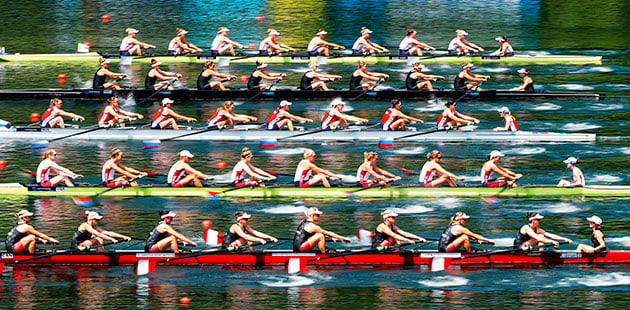
The U.S. women's eight (second from bottom) racing at the World Rowing Cup II in Lucerne, Switzerland in May.
Philipp Schmidli/Getty Images
After a week in the cool and seclusion of Hanover, N.H., the team returned to the familiar embrace of Princeton for final preparations. At the Olympics the U.S. will face six other boats—from Canada, Great Britain, the Netherlands, New Zealand, Romania and Russia—all of which are, in the words of Terhaar, “getting more and more professional and more and more competitive, and faster and faster all the time.”
In the end, though, he will keep his rowers focused on their own boat and their own race. Because their opening heat is on the first day of full competition—the gold medal race is on Aug. 13—the team will pass on attending the opening ceremony. He notes, though, that for the first time in several Games, the U.S. will be staying in the Olympic Village, where they will be surrounded by unaccustomed noise and constant activity—what he calls “a unique challenge.”
“They’re social people, personable people,” says Terhaar of his latest eight. “I’ve got to keep them realizing that there’s a really great party that starts right after your final—but it’s a lot more fun if you’ve got something heavy hanging around your neck.”
He’s not worried. “This group,” he says, “is really good at delayed gratification.”
